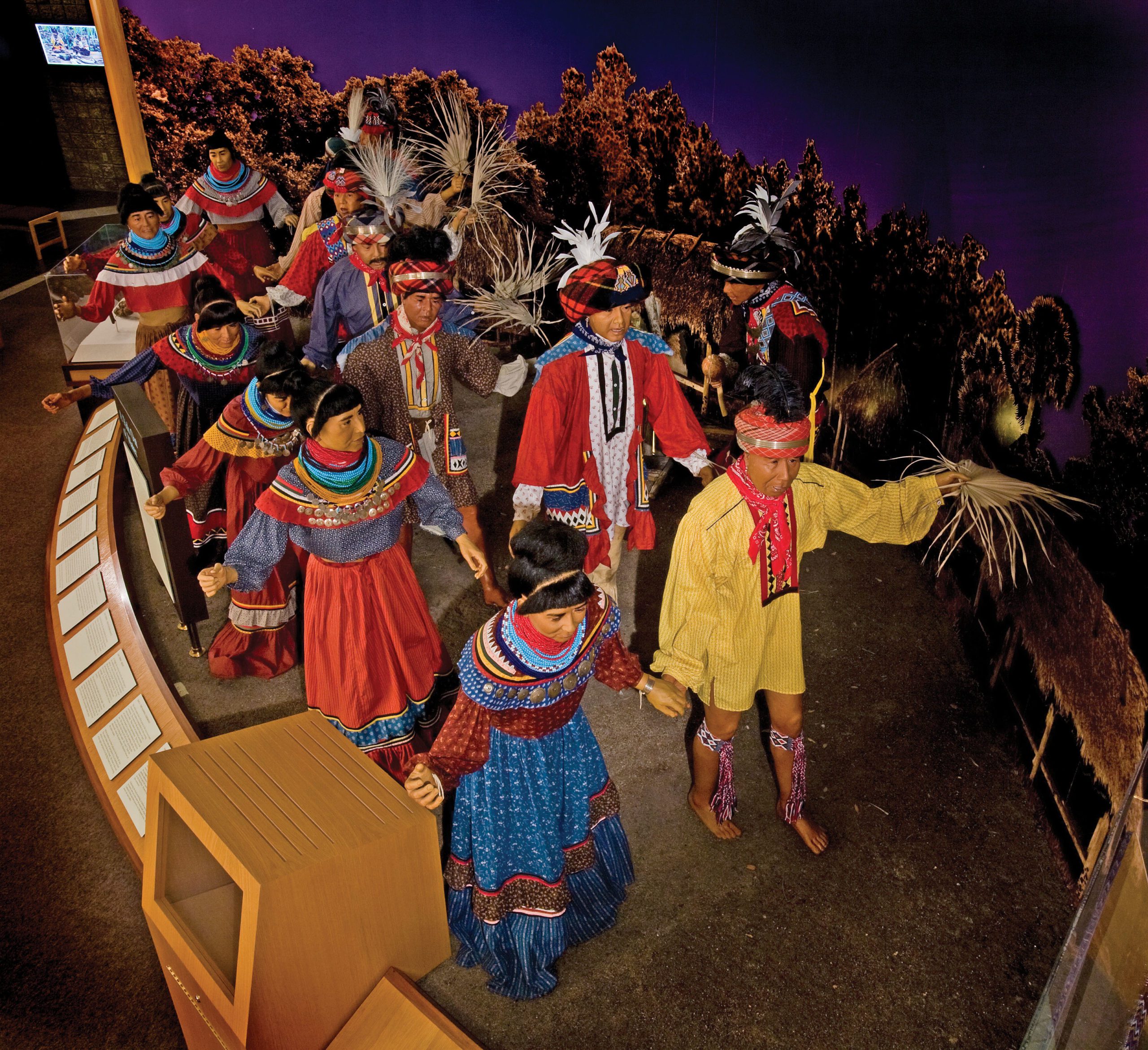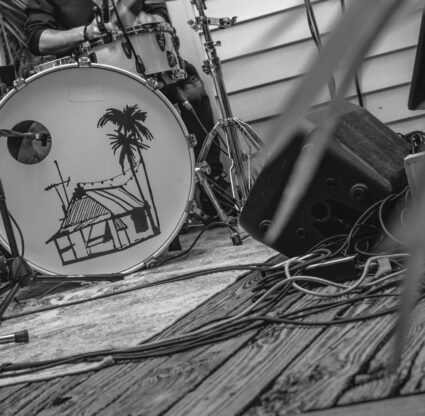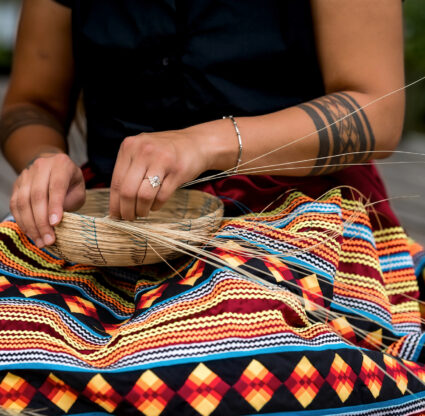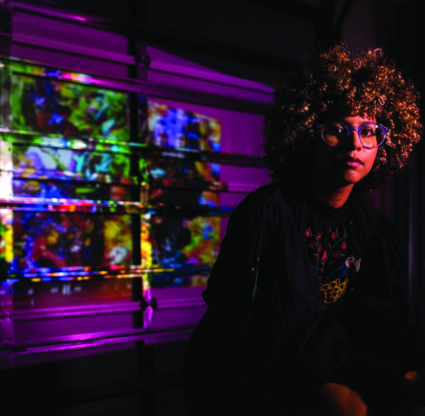In the grand scheme of things, we really haven’t been in Southwest Florida that long. And so it’s fascinating to think we have enough history to fill a museum. But the fact is we have lots of museums. And unique exhibits abound, telling this area’s amazing journey from forbidding tropical wilderness to paradise found. Here’s a sampling of what surprises, inspires and wows us.
Seminole Indian Lore
At the end of a mile-long boardwalk, gray smoke curls from a fire encircled by Seminole Indian chickee huts.
Lorraine Cypress sits under one of them, weaving a basket from wild sweetgrass.
The table in front of her displays her beadwork, dolls made of palmetto fibers, and signature Seminole patchwork. She is a woman of few words, but says she learned from her grandmother.
This “living village” is on the grounds of the Ah-Tah-Thi-Ki Museum, a fascinating look into Seminole Indian culture and traditions practiced in the late 19th century, still thriving in the 21st. The museum, on the Big Cypress Seminole Indian Reservation, lives up to its name. Translated loosely, it means “a place to learn, a place to remember.”
Life-size displays of early Seminole life are full of surprises. Like how they made animal hides velvety-soft by soaking them in a mixture of water and deer brains. Or the giant mortars and pestles women used to grind corn for sofkee, a kind of mush that was a diet staple.
The exhibit on the iconic Green Corn Ceremony, commonly called the Green Corn Dance, speaks to the heart of the Seminole culture.
The event, still held annually at a secret location, is one of purification and renewal. Various ceremonies ensure the tribe’s health, values and spiritual beliefs for another year. Tribal government business is conducted and criminal trials held.
All is accomplished in just four days. Congress could take note.
Florida’s First People, Among Others
The skeleton of a giant ground sloth greets visitors in the lobby of the Collier County Museum in Naples.
The prehistoric beast is a major hint that the museum goes way, way back.
Exhibits tell the story of the Paleo Indians, Florida’s first people 10,000 years ago, then the fierce Calusa, once 10,000 strong before disease brought by Spanish explorers wiped them out.
A remarkable Calusa artifact is the replica of the Marco Island Cat. The original, carved with shark-tooth knives and discovered on Key Marco in 1896, is in the Smithsonian Museum.
Tiny settlements didn’t start appearing in what became Collier County until the 1880s. With such a youthful history, it’s hard to imagine that anything of much significance could have happened here.
Au contraire. The county museum has four other branches in Immokalee, Marco Island, Everglades City and the Naples Depot that say otherwise, says Ron Jamro, the museum’s executive director. They all have unique stories with different personalities, events and economy.
Astonishingly, you learn that in the late 1880s, a 70-acre tract of what later became downtown Naples went for $2.50 an acre. When the county was created in 1923, it had fewer than 1,200 people.
The exhibit on building the Tamiami Trail (U.S. 41) boggles the mind. The first highway to connect the coasts of Florida from Tampa to Miami was started in 1923 by Barron Collier, the county’s namesake, and completed in 1928.
Cattle, Citrus and Cane
The Southwest Florida Museum of History focuses on the growth of Fort Myers and the region of Lee, Monroe, Hendry and Collier counties.
The museum is housed in a 1924-built former railroad depot in downtown Fort Myers. There was no railroad in Fort Myers until 1904, says James W. Powers, research historian. “You could not drive across the Caloosahatchee River until 1924.”
Yet exhibits show how Fort Myers became an economic power prior to the 20th century as a hub of the cattle industry. Combine that with the development of the citrus industry and ultimately the (sugar)cane industry and you have the three Cs of the Fort Myers economy: cattle, citrus and cane, Powers says.
This year marks the 150th anniversary of the battle of Fort Myers, Feb. 20, 1865. The Confederate Cattle Guard Battalion, known as the “Cow Cavalry,” attacked the fort. After several skirmishes, the Cow Cavalry withdrew.
The museum’s Florida in the Civil War exhibit continues through April 4.
Early Sanibel
It doesn’t seem possible: Sanibel Island was accessible only by boat until the Sanibel Causeway was built in 1963. There was no refrigeration, no mosquito control and no telephones to the outside world until the 1950s.
The Sanibel Historical Museum and Village tells the story of early Sanibel through a series of historical buildings that have been moved from other parts of the island and preserved. They form a small frontier village, including the old 1927 Bailey’s General Store, the first schoolhouse, the post office, and a 1926 cottage built from a kit ordered from Sears, Roebuck & Co.
The first permanent settlers didn’t come to the island until the 1890s. They farmed the land, growing vegetables, until a 1926 hurricane sent a storm surge over the island and ruined the soil for farming forever.
The Sears cottage is a favorite of museum visitors. The model ranged in cost from about $1,800 to $2,100. It arrived by barge in 30,000 pieces. Bailey’s store also served as a warehouse, packing center, communication center and voting place. It’s filled with examples of products from the era. Next to it was Miss Charlotta’s Tea Room, probably the last thing you’d expect to find on an isolated island. But it was a place for respite and a spot of tea while waiting for supplies to arrive or the boat back to the mainland. Utterly charming.
Ah-Tah-Thi-Ki Museum
30290 Jose Billie Highway, Clewiston; (877) 902-1113, ahtahthiki.com
Collier County Museum
3331 Tamiami Trail E., Naples; 252-8476, colliermuseums.com
Sanibel Historical Museum & Village
950 Dunlop Road, Sanibel; 472-4648, sanibelmuseum.org
Southwest Florida Museum of History
2031 Jackson St., Fort Myers; 321-7430, swflmuseumofhistory.com
World History Lesson
The holocaust museum & education Center of Southwest Florida attests to the power of hate and the power of hope.
The story of the Holocaust is told through survivors who live here, as well as liberators.
The museum helps people comprehend the magnitude of genocide, says Amy Snyder, the museum’s executive director. Six million Jews were killed by the Nazis, but 12 million people were killed overall in the Holocaust.
More than 1,000 items are on display. There is the extensive collection of armbands. There are also stars, triangles and other markings to isolate and identify prisoners. There are prison uniforms, photos of thousands of wedding rings, jewelry, nearly 300,000 pairs of shoes.
An exhibit called Dearest Pauline runs through May 3. It features the letters and documents of Dr. Price Duff, who treated concentration camp survivors as the camps were liberated.
—LB
The Holocaust Museum & Education Center of Southwest Florida, 4760 Tamiami Trail N., Suite 7, Naples, 263-9200, holocaustmuseumswfl.org





